Abstract
A highly penicillin-resistant beta-lactamase-producing strain of Clostridium butyricum, strain NBL 3, was isolated. The specific activity of the unpurified beta-lactamase was 0.29 U/mg of protein. The enzyme was purified 1,130-fold by QAE Zetaprep, Sephacryl S-300, and Mono Q column passages. The purified enzyme was judged homogeneous by sodium dodecyl sulfate gradient gel electrophoresis and fast protein liquid chromatography. The enzyme hydrolyzed phenoxymethylpenicillin, benzylpenicillin, ampicillin, and carbenicillin more rapidly than piperacillin and cephaloridine. Cephalothin, cephalexin, cefoxitin, moxalactam, cefotaxime, and imipenem were only slightly hydrolyzed, at less than 1% the rate for phenoxymethylpenicillin. The enzyme was inhibited by clavulanic acid, sulbactam, tazobactam, and p-chloromercuribenzoate. The molecular weight was determined by gel filtration and sodium dodecyl sulfate gradient gel electrophoresis to be 32,000. The isoelectric point was 4.4. Aspartic acid-asparagine, glutamic acid-glutamine, leucine, lysine, alanine, and serine dominated the amino acid composition.
Full text
PDF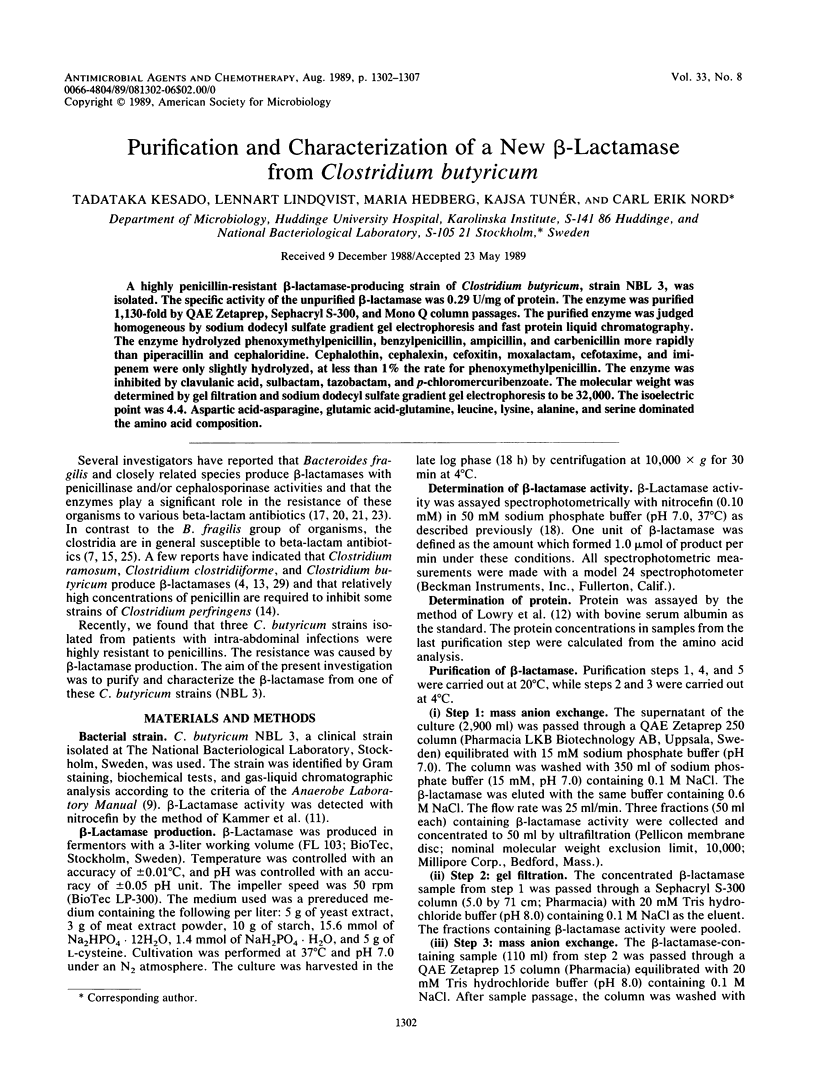
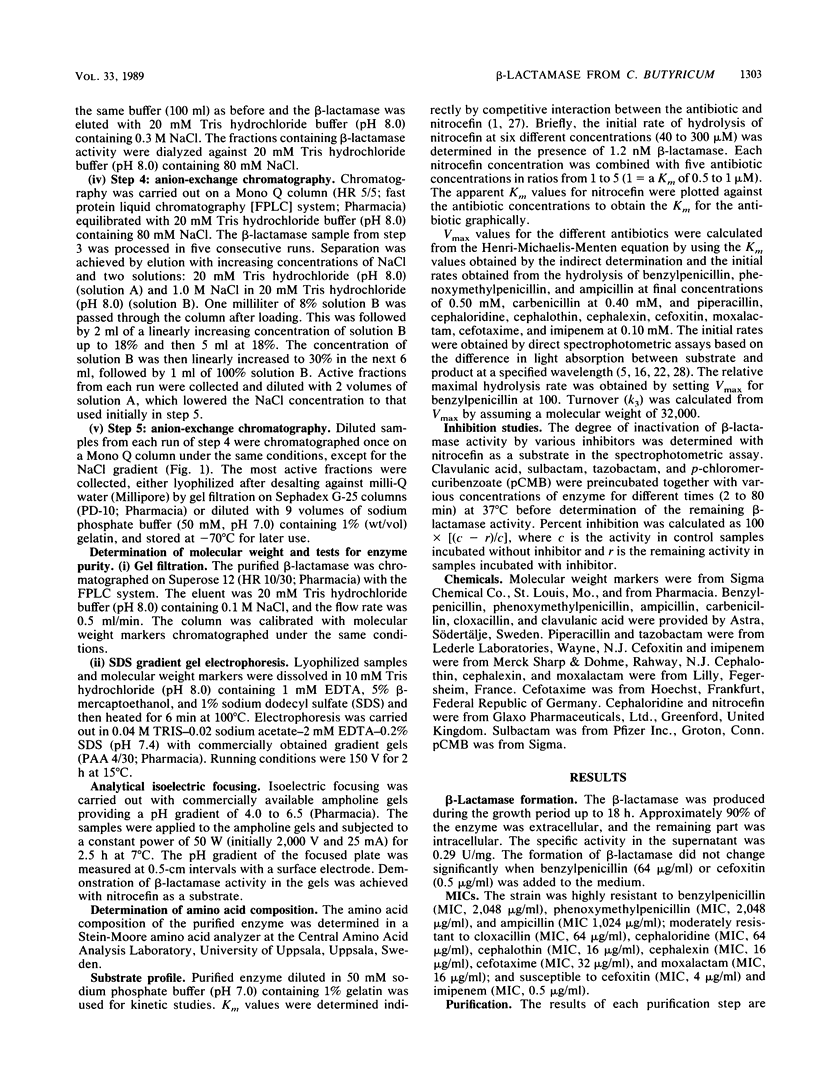
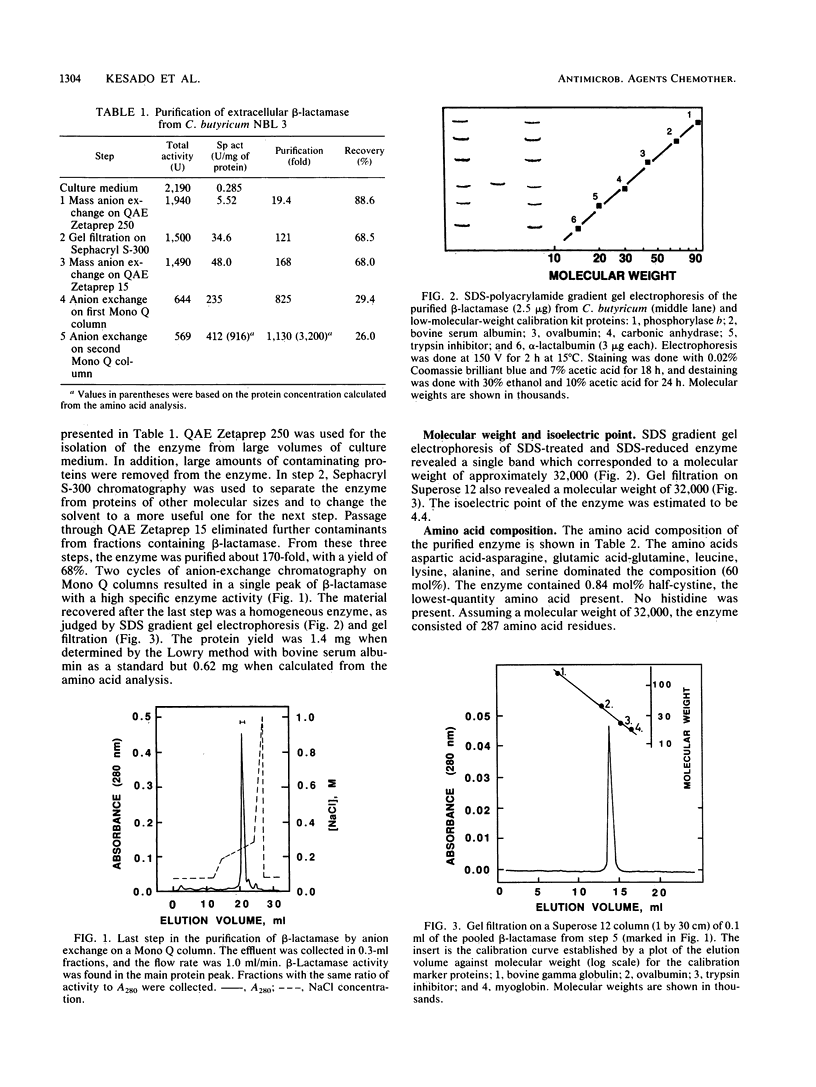
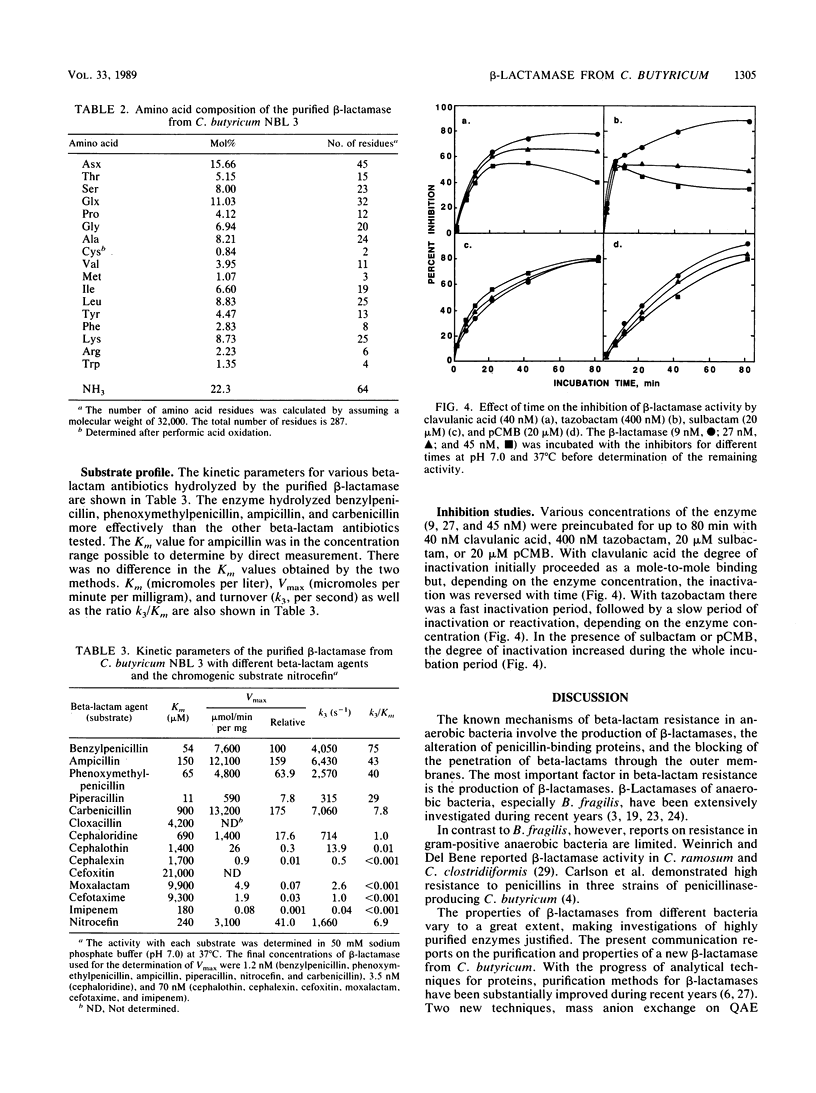
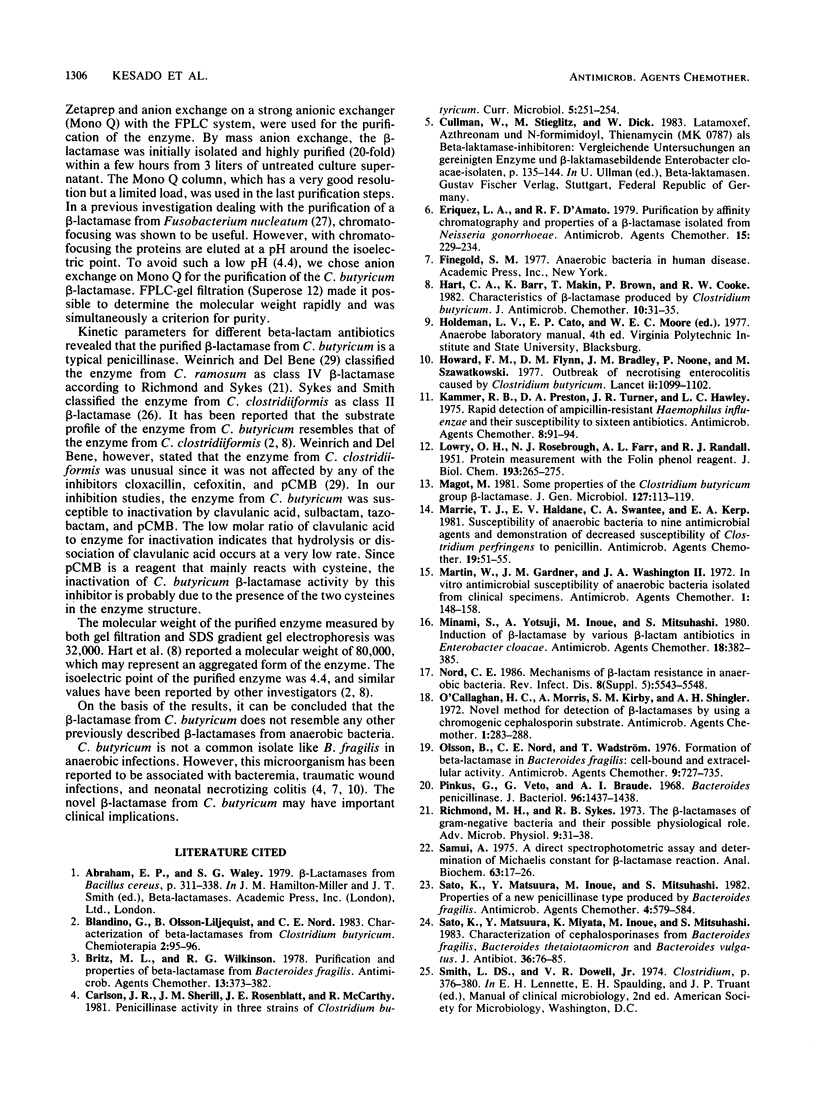
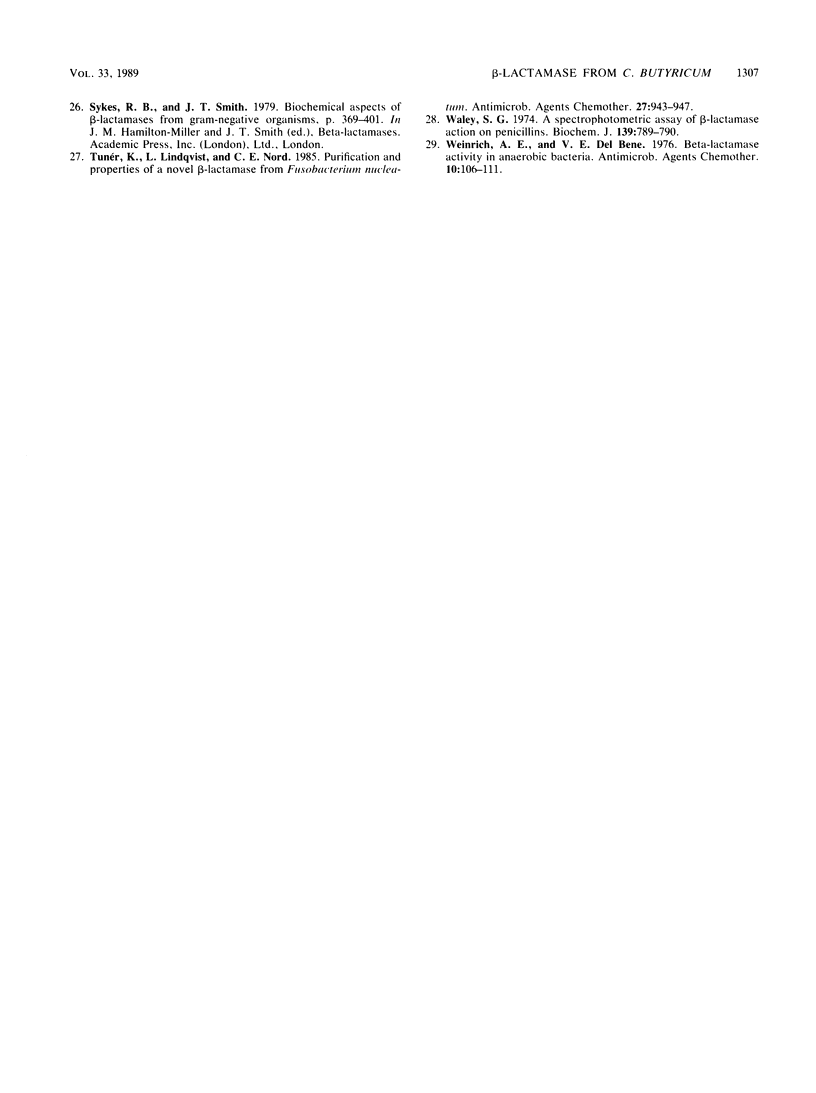
Selected References
These references are in PubMed. This may not be the complete list of references from this article.
- Britz M. L., Wilkinson R. G. Purification and properties of beta-lactamase from Bacteroides fragilis. Antimicrob Agents Chemother. 1978 Mar;13(3):373–382. doi: 10.1128/aac.13.3.373. [DOI] [PMC free article] [PubMed] [Google Scholar]
- Eriquez L. A., D'Amato R. F. Purification by affinity chromatography and properties of a beta-lactamase isolated from Neisseria gonorrhoeae. Antimicrob Agents Chemother. 1979 Feb;15(2):229–234. doi: 10.1128/aac.15.2.229. [DOI] [PMC free article] [PubMed] [Google Scholar]
- Hart C. A., Barr K., Makin T., Brown P., Cooke R. W. Characteristics of a beta-lactamase produced by Clostridium butyricum. J Antimicrob Chemother. 1982 Jul;10(1):31–35. doi: 10.1093/jac/10.1.31. [DOI] [PubMed] [Google Scholar]
- Howard F. M., Flynn D. M., Bradley J. M., Noone P., Szawatkowski M. Outbreak of necrotising enterocolitis caused by Clostridium butyricum. Lancet. 1977 Nov 26;2(8048):1099–1102. doi: 10.1016/s0140-6736(77)90546-3. [DOI] [PubMed] [Google Scholar]
- Kammer R. B., Preston D. A., Turner J. R., Hawley L. C. Rapid detection of ampicillin-resistant Haemophilus influenzae and their susceptibility to sixteen antibiotics. Antimicrob Agents Chemother. 1975 Jul;8(1):91–94. doi: 10.1128/aac.8.1.91. [DOI] [PMC free article] [PubMed] [Google Scholar]
- LOWRY O. H., ROSEBROUGH N. J., FARR A. L., RANDALL R. J. Protein measurement with the Folin phenol reagent. J Biol Chem. 1951 Nov;193(1):265–275. [PubMed] [Google Scholar]
- Magot M. Some properties of the Clostridium butyricum group beta-lactamase. J Gen Microbiol. 1981 Nov;127(1):113–119. doi: 10.1099/00221287-127-1-113. [DOI] [PubMed] [Google Scholar]
- Marrie T. J., Haldane E. V., Swantee C. A., Kerr E. A. Susceptibility of anaerobic bacteria to nine antimicrobial agents and demonstration of decreased susceptibility of Clostridium perfringens to penicillin. Antimicrob Agents Chemother. 1981 Jan;19(1):51–55. doi: 10.1128/aac.19.1.51. [DOI] [PMC free article] [PubMed] [Google Scholar]
- Martin W. J., Gardner M., Washington J. A., 2nd In vitro antimicrobial susceptibility of anaerobic bacteria isolated from clinical specimens. Antimicrob Agents Chemother. 1972 Feb;1(2):148–158. doi: 10.1128/aac.1.2.148. [DOI] [PMC free article] [PubMed] [Google Scholar]
- Minami S., Yotsuji A., Inoue M., Mitsuhashi S. Induction of beta-lactamase by various beta-lactam antibiotics in Enterobacter cloacae. Antimicrob Agents Chemother. 1980 Sep;18(3):382–385. doi: 10.1128/aac.18.3.382. [DOI] [PMC free article] [PubMed] [Google Scholar]
- O'Callaghan C. H., Morris A., Kirby S. M., Shingler A. H. Novel method for detection of beta-lactamases by using a chromogenic cephalosporin substrate. Antimicrob Agents Chemother. 1972 Apr;1(4):283–288. doi: 10.1128/aac.1.4.283. [DOI] [PMC free article] [PubMed] [Google Scholar]
- Olsson B., Nord C. E., Wadström T. Formation of beta-lactamase in Bacteroides fragilis: cell-bound and extracellular activity. Antimicrob Agents Chemother. 1976 May;9(5):727–735. doi: 10.1128/aac.9.5.727. [DOI] [PMC free article] [PubMed] [Google Scholar]
- Pinkus G., Veo G., Braude A. I. Bacteroides penicillinase. J Bacteriol. 1968 Oct;96(4):1437–1438. doi: 10.1128/jb.96.4.1437-1438.1968. [DOI] [PMC free article] [PubMed] [Google Scholar]
- Richmond M. H., Sykes R. B. The beta-lactamases of gram-negative bacteria and their possible physiological role. Adv Microb Physiol. 1973;9:31–88. doi: 10.1016/s0065-2911(08)60376-8. [DOI] [PubMed] [Google Scholar]
- Samuni A. A direct spectrophotometric assay and determination of Michaelis constants for the beta-lactamase reaction. Anal Biochem. 1975 Jan;63(1):17–26. doi: 10.1016/0003-2697(75)90185-2. [DOI] [PubMed] [Google Scholar]
- Sato K., Matsuura Y., Inoue M., Mitsuhashi S. Properties of a new penicillinase type produced by Bacteroides fragilis. Antimicrob Agents Chemother. 1982 Oct;22(4):579–584. doi: 10.1128/aac.22.4.579. [DOI] [PMC free article] [PubMed] [Google Scholar]
- Sato K., Matsuura Y., Miyata K., Inoue M., Mitsuhashi S. Characterization of cephalosporinases from Bacteroides fragilis, Bacteroides thetaiotaomicron and Bacteroides vulgatus. J Antibiot (Tokyo) 1983 Jan;36(1):76–85. doi: 10.7164/antibiotics.36.76. [DOI] [PubMed] [Google Scholar]
- Tunér K., Lindqvist L., Nord C. E. Purification and properties of a novel beta-lactamase from Fusobacterium nucleatum. Antimicrob Agents Chemother. 1985 Jun;27(6):943–947. doi: 10.1128/aac.27.6.943. [DOI] [PMC free article] [PubMed] [Google Scholar]
- Waley S. G. A spectrophotometric assay of beta-lactamase action on penicillins. Biochem J. 1974 Jun;139(3):789–790. doi: 10.1042/bj1390789. [DOI] [PMC free article] [PubMed] [Google Scholar]
- Weinrich A. E., Del bene V. E. Beta-lactamase activity in anaerobic bacteria. Antimicrob Agents Chemother. 1976 Jul;10(1):106–111. doi: 10.1128/aac.10.1.106. [DOI] [PMC free article] [PubMed] [Google Scholar]


